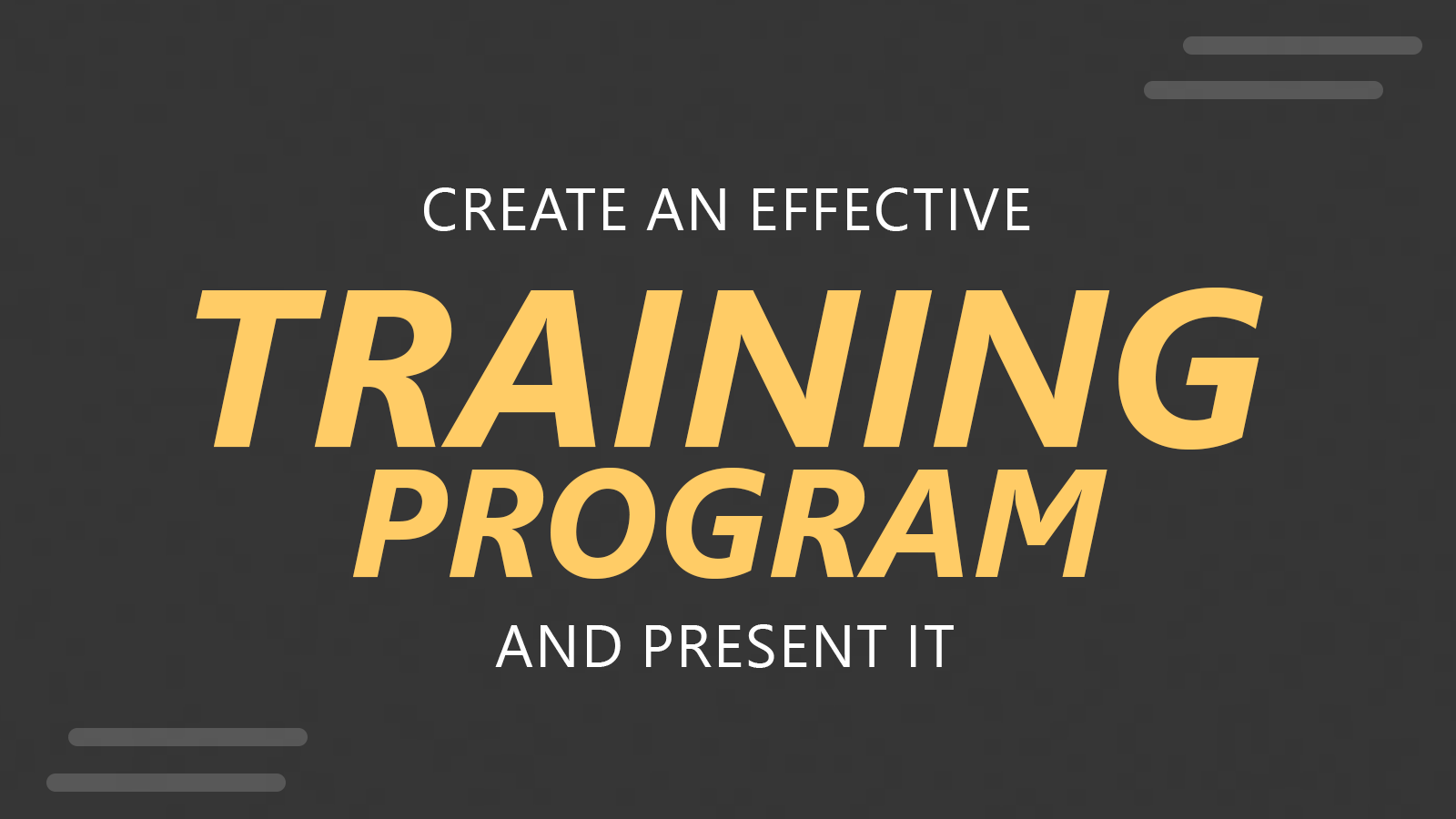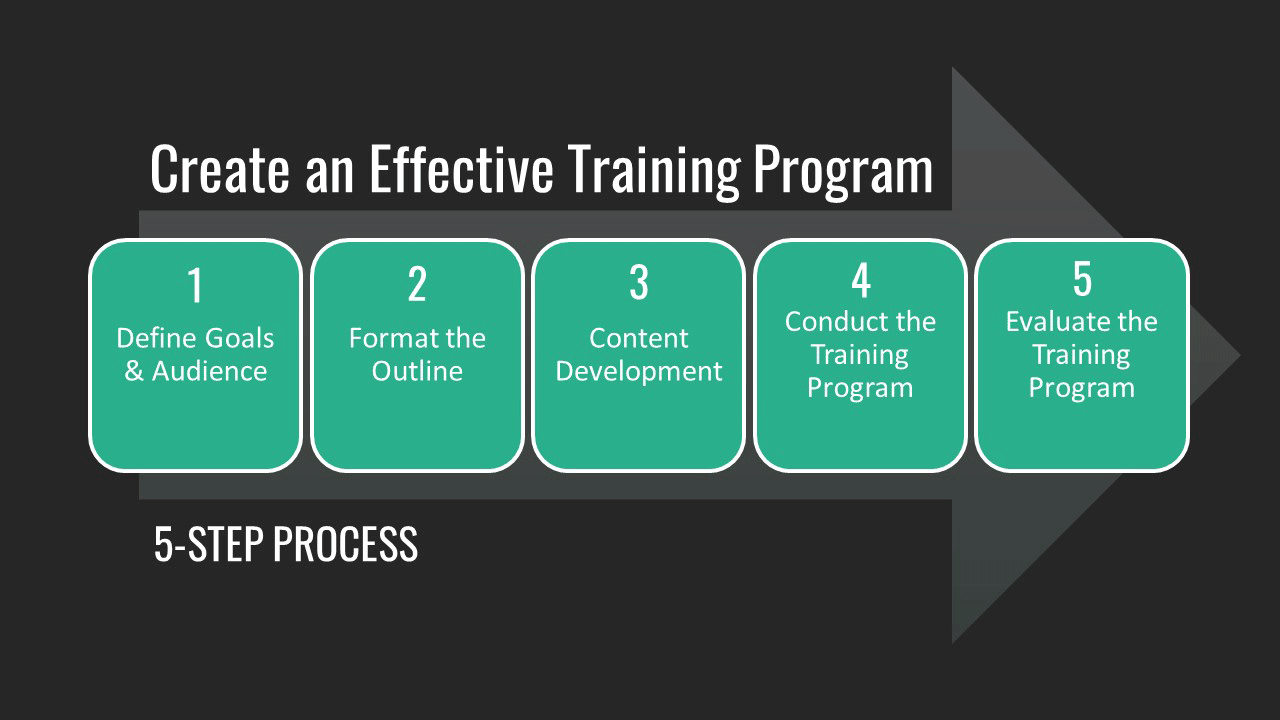How to Create an Effective Training Program and Present It? (An Actionable 5-Step Guide)

Effective workplace training programs can help businesses and companies in getting higher productivity and effectiveness leading to higher revenue generation and growth avenues for businesses. Being a business manager or executive, you may be in constant need of engaging your staff members, their efficient compliance with the company’s rules and regulations, and their higher job satisfaction rate.
In order to achieve all these milestones, an effective training program can surely help you boost the growth of your company and ultimately achieve all the aforementioned objectives. However, what exactly is meant by a training program? What are the various types of training programs? Is there an actionable mechanism to conduct an effective training program? All of these important questions will be answered in this ultimate guide. Hence, make sure to remain engaged and attentive throughout this article so that you won’t miss any important step needed to conduct a top-notch training program.
What is a Training Program?
Regarding the business landscape, a training program is a mechanism in which businesses and companies train their employeesper the processes, job duties, policies, norms, rules, and regulations of a specific company’s workplace environment and needs.
With effective training programs in practice, employees can enhance their working potential by renovating their skills, expertise, and working styles so that they may achieve higher professional goals. Another term that is often confused with the training program is employee development. In terms of applications and scope, employee development is a relatively broader term. It is more focused on the future roles of the employees than their current ones. However, both training programs and employee development are meant to enhance the skills and specific knowledge of the employees to help them excel in their professional journeys.
What is the Importance of Training Programs?
According to a report by the International Journal of Business and Management Research, almost 90% of employees and professionals agree that the training programs help them boost their professional growth and improve their job performance.
They Help in Improving the Soft and Hard Skills of the Employees
Training programs become imperative when it comes to handling new job responsibilities, learning about the latest and innovative job practices and technologies, and especially, adapting to remote working. Training programs are also crucial for improving the soft skills of the employees for better team communication and collaboration. These programs help in improving task management, motivating employees to continuous improvement, and instilling confidence in them.
They Ensure Better Employee Engagement
Training programs also clarify the results that are expected by the company from the employees. Moreover, employee engagement also increases when an effective training program is conducted. Resultantly, employee turnover also reduces.
They Help in Improving the Company’s Culture and Reputation
When the employees are trained equally with measurable milestones, they also help improve the company culture. Transparency and positivity prevail in workplaces where employees listen to each other’s needs and learn from their mistakes. Better training programs are essential for attracting and retaining talented candidates for the desired job roles. Ultimately, the overall business reputation also gets strengthened when an effective training program is in place.
4 Types of Training Programs
In order to fulfill the needs of a specific business, a number of training program types can be considered to achieve the desired objectives. Some of the most prominent training program types are given as follows.
1. Instructor-Based Training
In this training program type, an instructor teaches his students in person in a closed space or room. The training can either be conducted physically where all students and the instructors are physically present and interact with each other or it can be initiated in a virtual classroom where employees (trainees) and instructor (trainer) interact with each other remotely by using processes like video conferencing, etc.
2. Coaching and Mentoring
In this specific type of training, the trainee is not trained by conventional methods where he gets lectures from the instructor in front of a whiteboard. In this specific type of training program, the trainee is guided by a mentor or coach in the practical setting by using a guided learning approach. The mentor shares his experiences, expertise, and knowledge with the trainee in the practical scenarios so that he may excel in his professional journey with distinction while achieving the organizational objectives as well.
3. On-Board Training
Sometimes, the training of the employees starts after they are taken on board. The idea is to train the mentees in practical scenarios where they are assigned to specific tasks under the supervision of their superiors. Hence, they analyze the tasks being performed by their senior executives and then they start performing those tasks and activities on their own.
4. Remote Learning or eLearning
In this type of training program, a digital means of communication is used between the trainees and instructors. This digital medium can be a computer screen, LCD, mobile phone, laptop, and more. From watching an instructional video to taking a relevant quiz, from playing an instructional game to listening to an instructor through any kind of digital device can be regarded as remote learning practices. In the modern digital learning era, the softwares like Zoom, Microsoft Teams, and Google Meets have revolutionized the eLearning space and many businesses have permanently added this relatively new kind of instructional mode to their portfolio of training programs.
5-Step Guide to Developing a Training Program
In order to draft a successful training program and resultantly enhance the experience of the employees, a step-by-step instructional guide for an effective training program is given as follows.

1. Understand the Training Goals and Target Audience
The head of a Sales team can coin the idea of a specific training program for his employees if he feels that the employees are not using their work hours properly and reaching their KPIs. In order to start the development of a training program, you must know about some of the needs and goals of your training program.
Why is there a need for a training program? Do you want to increase your sales? Are you looking for better employee engagement and collaboration? Do you need to reach a specific KPI? All of these questions and similar ones can be asked in order to move through this phase and formulate a well-balanced approach from the very beginning. You also need to keep in mind your listeners as well. How many are they? Who are they? What is their background? Are they familiar with the topic of discussion or not? Ask yourself such questions, and you will have a sound understanding of the needs, wants, and desires of your audience.
2. Format the Outline of your Program
Until now, you must have analyzed the whole content that is needed to be presented in front of an audience. Hence, you must compile all the relevant data and information, and pick a suitable format and some relevant and understandable metrics for monitoring the course of the program.
You must define your learning objectives at this stage. You can divide your main goals into further sub-goals in order to make the desired results more achievable. Now, you are ready to deploy your instructional tactics. First of all, you need to be prepared and ready to stimulate interest in your listeners about the topic being explained. The next stage is presenting your data and information. In this stage, you try to present your arguments, knowledge, and expertise in the most appealing and understandable manner. For this purpose, you can leverage slide presentations as they are a fine amalgam of textual and visual content.
A well-designed slide presentation will help you greatly in achieving your desired goals as listeners will be viewing compelling graphics like images, infographics, charts, tables, graphs, videos, etc. It is a well-known fact that the human brain processes visual data and information more speedily than textual ones. Therefore, you will be able to present your ideas and knowledge while keeping the audience engaged throughout your speech.
If you are a PowerPoint user, you are in luck. Our website Free PowerPoint Templates is offering thousands of premade PowerPoint free of cost. Avoid the hassle of designing each and every slide of your presentation and download the professionally designed premade templates from an ocean of the best possible PowerPoint templates that you will ever find on the internet. Preparing and designing your slides was never this easy.
3. Content Development
You should incorporate a diversified list of modules of training in your training program. By using different modes and means of training, you will be able to gain and retain the attention of your listeners.
You also need to consider the effective development of your training materials no matter what type of training program is under discussion. For example, if you are considering an eLearning training program for your employees, you can hire a team of graphic designers, voice-over artists, and video editors to develop engaging content for your audience. With the help of AI tools and generative AI, you can create amazing content for your training program, including stories, ebooks, AI-generated presentations and documents.
4. Conduct the Training Program
At this stage, you must proceed by conducting your training program. You can inform your trainees about the possible venue, time, and mode of the training program before the start of your session. You need to make sure that everything is clear to everyone from the very beginning and everyone is listening to your speech attentively. Make your expectations and desired results clear so that trainees are well aware of what is expected of them at the end of the session.
5. Evaluate your Training Program
Once you are finished with your training program, you need to determine the rate of success of your training. For this purpose, you can ask for feedback from your employees or mentees. For this purpose, you can ask any random professional face-to-face or conduct an anonymous online survey in which every trainee can share his opinions about the effectiveness of the training program.
You can test the success of your training program by conducting quizzes or small question-answer sessions with your audience. Moreover, you can analyze the job proficiency and productivity of the employees yourself after completing your training session. If they have improved their work efficiency and are aiming for higher goals now, you have achieved the objective of your training program. Quantifiable business results are another way of judging the success of your training program.
Final Words
Training programs are designed by businesses to share knowledge, expertise, and skill sets with the trainees with respect to their relevant job duties. They are important for reducing employee turnover and enhancing workplace productivity. They also boost the engagement and soft and hard skills of the employees. These training sessions are important for improving the workplace culture and the company’s reputation.
There are several types of training programs instructor-based training, coaching, on-board training, and eLearning. All of these training types leverage various modes, and means of interacting with their audience and achieving the desired organizational objectives.
In order to develop an effective and actionable training program, you must understand the needs and goals of your training program. You must also be aware of your audience’s desires, learning behaviors, and wants. After passing through this stage, you need to format your training program so that you can present it effectively. Content development is also another important part of the whole process especially in the case of eLearning training programs. You must conduct the training by organizing all the parameters relevant to your audience and training goals. In the end, you must evaluate the effectiveness of your training program so that you can analyze the results of the already conducted training and incorporate useful suggestions into future training programs.
